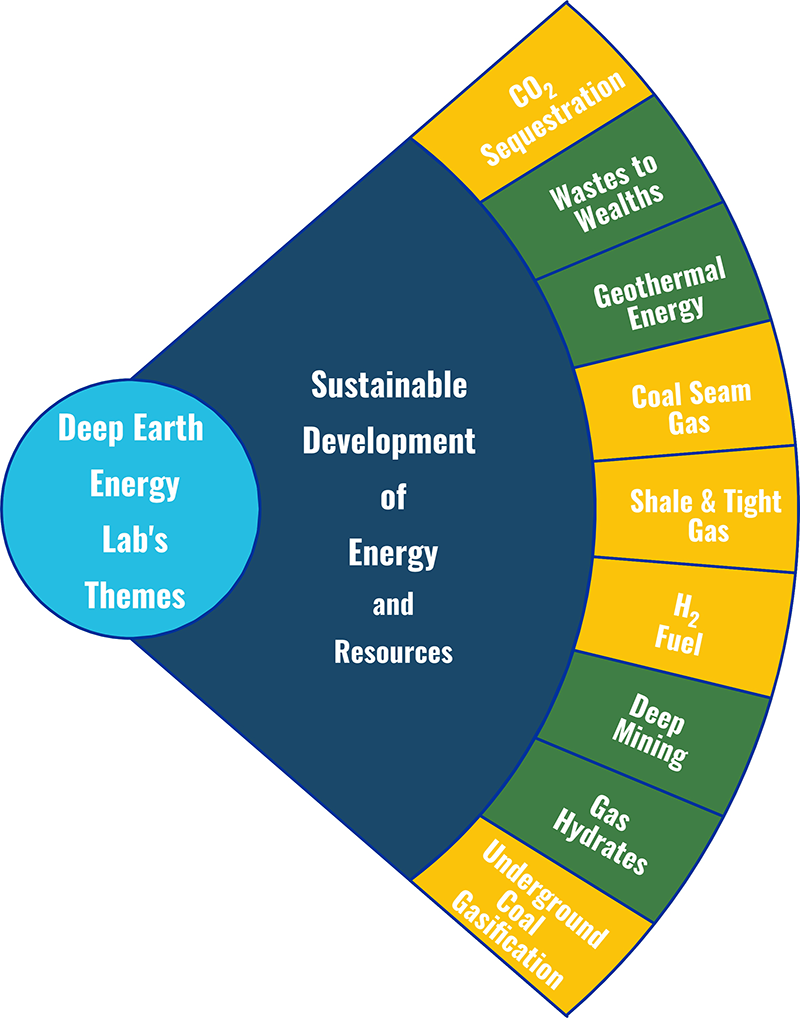
Carbon Sequestration
Our ultimate research goal is to provide innovative research solutions to the problems caused by climate change and global warming. The research has led to a greater understanding of the storage capacity of sedimentary basins and the identification of optimum injection conditions for geo-sequestration in such aquifers, and any potential mechanisms that could lead to migration of CO2 from the source rock back to the atmosphere. Thus, it supports to reduce CO2 leakage risks in aquifers, raise public awareness of sequestration, and foster trust in experts. The studies are focused on hydro-chemico-mechanical behaviours of storage basins under CO2 sequestration environment in short and long-term runs using laboratory experiments and numerically models.
Monash researchers at DEEL will contribute to national and global efforts to reduce global warming, safeguard the Australian economy, and enable the transition to new green energy production technologies.
Waste to Wealth
Today, waste generation is increasing at an alarming rate with the rapid development of the industrial sectors and as the complex lifestyles of the growing population. The major problems related to these types of waste include the use of large landfilling areas, contamination of both groundwater and the atmosphere by hazardous materials, potential landslides from waste dumps, and the cost and energy requirements of haulage and collection. The possible inclusion of wastes in cement binders is a viable solution to overcome the negative effects of waste generation.
Alkali-activated materials (AAMs) have the potential to consume considerable amounts of waste materials such as coal ashes, metal slags, mine waste, municipal waste, agricultural waste, and construction waste, thereby contributing to the elimination of adverse environmental impacts. Ultimately, re-using these types of waste in AAMs produces cost- and emission-effective binders with lower energy consumption than ordinary Portland cement (OPC) binders which leads to sustainable construction practices.
Geothermal Energy
The desired energy production from world geothermal plants was not achieved due to multiple challenges experienced during operation of enhanced geothermal systems (EGSs). The major issues encountered include the occurrence of low flow rates, higher production costs, and difficulty in formation of a well-interconnected fracture network in the deep rock. Currently, water is used as the working fluid in EGS, and a million gallons of water is injected into the deep earth during EGS operation. The use of supercritical carbon dioxide (ScCO2) in EGS, replacing water is a promising approach due to its superlative advantages in addressing the major challenges prevailing in water-based EGS. Mainly, the injection of CO2 into deep earth combines the CO2 sequestration with geothermal energy extraction.
The use of ScCO2 as the working fluid in EGSs by replacing water contributes to the development and operation of an EGS with low energy consumption. Importantly, the formation of well-interconnected underground geothermal reservoir influences in enhancing production flowrates and heat extraction. Accordingly, the use of ScCO2 in an EGSs opens up the pathways for renewable energy production by earning credits for storing greenhouse gasses.
Coal Seam Gas
Coalbed methane (CBM) will be, by far, Australia’s most important unconventional gas source in the short term. It provided almost 30% of gas production in Australia and over 60% of that in Queensland. Primary CBM production by dewatering can only recovery less than 50% of gas in place. Monash is at the forefront of developing more environmentally friendly techniques to improve the extraction, including enhanced CBM recovery by injection of CO2 or N2 and reservoir stimulation by using supercritical CO2. We have developed a novel experimental system for in-situ X-ray microtomography combining with core flooding tests, which bridges macro-scale behaviours and cleat-scale mechanisms.
Shale Gas
Gas is now the third-largest energy source in Australia after coal and oil. Australia’s growing energy demand, in an environment of declining conventional gas output, presents definite challenges: the increasing cost of offshore gas, declining national self-sufficiency in liquid hydrocarbons, reduced carbon footprint in energy consumption as a new global imperative, and growing economies in Asia that are increasingly hungry for gas. We are focusing on the development of a novel, environmentally friendly technique to improve the extraction of shale gas: an affordable, reliable technique that will increase its utility as a safe and sustainable energy resource.
Hydrogen as Fuel
With the realization of hydrogen energy as a clean energy source, significant attention has been paid towards the production methods of hydrogen gas, especially towards the conversion of natural gas into pure hydrogen. With the focus to develop zero-emission energy sources, researchers of DEEL have advanced another step with the recent assimilation of methane conversion techniques into their researches broadening the horizon.
Deep Mining
Despite a dramatic increase in global demand for minerals, ore grades tend to decline with increasing mineral extraction, thereby exponentially increasing the energy consumption in conventional mining practices. As an alternative, In-Situ Leaching (ISL), a solution mining method can be adopted to eliminate the energy-intensive operations and increasing waste. However, the applicability of ISL is limited to porous rock, and there is a risk of groundwater contamination from lixiviant. Impermeable host rocks may require preconditioning before ISL by adopting an artificial fracture stimulation method like hydraulic fracturing. However, hydraulic fracturing is detrimental to the ISL process due to the adverse environmental impacts and uncontrolled fracture propagation. Researchers at DEEL will contribute to developing a sustainable preconditioning method for ISL applications.
Natural Gas Hydrates
Natural gas hydrates have been identified as an unconventional source of methane gas, with vast storage which is estimated to be larger than all other natural gas sources combined. Besides, it is inferred that hydrate accumulations have the potential to store CO2 through gas replacement processes providing a unique opportunity to address two of the most considerate concerns of the contemporary policies: energy generation and reducing the anthropogenic CO2 emissions. Understanding this vital scenario, Monash University researchers are developing sustainable methods for the extraction of methane from marine hydrate reservoirs with state-of-art laboratory facilities in DEEL, intending to become the frontiers of gas hydrate research in Australia.
